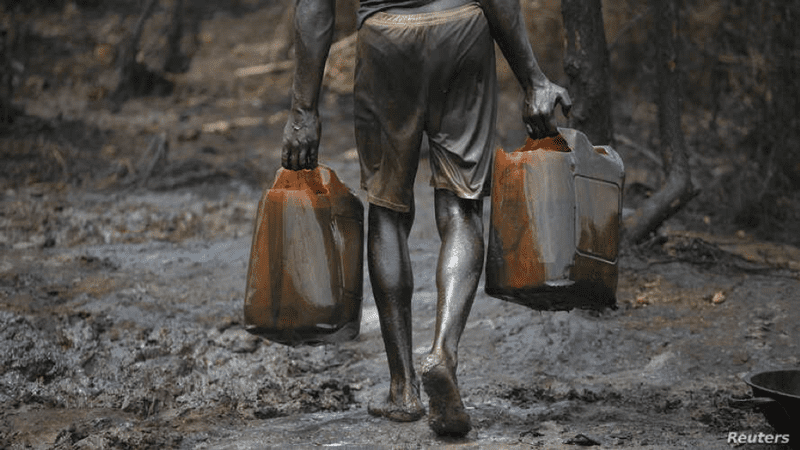The famous London-based Ernst & Young (EY) audit and consulting company estimates that around $133 billion worth of crude oil and refined products are stolen or adulterated every year. These practices fund dangerous non-state actors such as the Islamic State, Mexican drug cartels, Italian mafia, Eastern European criminal groups, Libyan militias, Nigerian rebels and more and are a major global security concern. [1]
This theft mainly occurs through the illegal tapping of oil pipelines. By installing illicit taps, thieves can divert oil or other refined products from pipelines. Mexican drug gangs, for example, can earn $90,000 in just several minutes from illegal pipeline tapping. [2]
There are two basic methods of tapping oil pipelines: cold and hot.
Cold tapping allows work to be performed on a section of pipeline without flooding of the line. A tap is performed on either end of the pipeline section, and plugs are inserted into the pipeline and inflated. The section of line to be modified is then removed, and the new section of line is installed by conventional hyperbaric welding. Once complete, the line is repressurized, and the plugs are removed by pigging.
In its turn, hot, or pressure tapping, is the method of making a connection to existing piping without interrupting or emptying that section of pipe. This means that a pipe can continue to be in operation while maintenance or modifications are being done to it. The process is also used to drain pressurized casing fluids and add test points or various sensors such as temperature and pressure. Hot taps can range from a 1/2-inch hole designed for something as simple as quality control testing, up to a 48-inch tap for the installation of a variety of ports, valves, t-sections or other pipes. This method is more dangerous as it involves a risk of unwanted ignition from metal equipment sparks but naturally, as a rule, is used by illegal tappers.
In addition to the financial consequences of illegal tapping, the integrity of the pipeline and the increased risk for a smooth, continuous operation can be detrimental. Finding the exact position of the illegal tap is also challenging since crooks find ways to hide their lucrative business in a professional manner. Moreover, advanced leak detection systems might be able to detect the loss of pressure, but the mass balance probably does not give a clear answer on the loss of product and its location(s).
While pipeline theft in places like Nigeria and Mexico are the most common images associated with the theft of hydrocarbons, the problem is actually far broader and more systematic in nature. Illegal bunkering, ship-to-ship transfering, armed theft (or piracy), bribing corrupt officials, oil smuggling and laundering, and fuel adulteration are also widely used in this criminal sphere. [2]
Illegal Bunkering: Oil acquired by thieves is pumped to small barges, which are then sent to sea to deliver the product to tankers. In Nigeria, for example, the Niger Delta’s infamous labyrinth of creeks is the perfect place for bunkering to go undetected.
Ship-to-Ship Transfering involves a transfer of illegal fuel to a more reputable ship, which then can be passed off as legitimate imports. For example, refined crude from Libya gets transferred ship-to-ship in the middle of the Mediterranean to be illegally imported into the EU.
Armed Theft (Petro-Piracy) entails using the threat of violence to an oil-carrying ship, demanding ransoms and sometimes confiscating the tanker or its cargo. Even though Hollywood has made offshore Somalia infamous for its pirates, it is the Gulf of Guinea near Nigeria that ships need to be worried about. In the last few years, there have been hundreds of attacks.
Bribing Corrupt Officials: In some countries – as long as the right person gets a cut of oil profits – authorities will turn a blind eye to hydrocarbon theft. In fact, E&Y says an astonishing 57.1 percent of all fraud in the oil and gas sector relates to corruption schemes.
Smuggling and Laundering: Smuggling oil products into another jurisdiction can help enable a profitable and less traceable sale. ISIS is famous for this – it can’t sell oil to international markets directly, so it smuggles oil to Turkey, where it sells it at a discount.
Fuel Adulteration is a sneaky process in which unwanted additives are put in oil or refined products and then sold at full price. In Tanzania, for example, adding cheap kerosene and lubricants to gasoline or diesel is an easy way to increase profit margins, while remaining undetected.
The impact of fuel theft on people and the economy is significant and wide-ranging. Companies in oil and gas can lose billions of dollars from fuel theft. Case in point: Pemex, Mexico’s national oil company, is estimated to lose $1.3 billion per year as a result of illegal pipeline tapping by gangs (see below). In Ireland, for instance, the government claims it loses approximately $182 million to $303 million in revenues per year from fuel adulteration. ISIS and other terrorist groups have used hydrocarbon theft and sales as a means to sustain operations. At one point, ISIS was making $50 million per month from selling oil. The Zetas cartel in Mexico controls nearly 40 percent of the fuel theft market, raking in millions each year (see Figure 1). [2]
![Oil Theft: A Frightening International Perspective 4 Figure 1. Economic Dimensions of Oil Theft in Selected Countries. Click to view full infographic. Source: www.visualcapitalist.com/global-black-market-fuel-theft [5]](https://b1006343.smushcdn.com/1006343/wp-content/uploads/2021/02/black-market-illicit-oil-1.png?lossy=2&strip=1&webp=1)
View full infographic here: www.visualcapitalist.com/global-black-market-fuel-theft [5]
Not only does fuel theft cost corporations and governments severely, but there is also an environmental impact to be considered. Fuel spills, blown pipelines and engine damage from adulterated fuel are all huge issues.
Nigeria. It is estimated that Nigeria alone loses $1.5 billion a month (or a staggering $18 billion per year) due to pipeline tapping, illegal production and other sophisticated schemes. [1]
The story of how Nigeria’s crude goes missing has been told for years. To steal oil, thieves tap into pipelines and other infrastructure in the Niger Delta. They then pump the oil onto waiting barges and boats. Some of it is refined locally while larger vessels carry the rest abroad. There are also allegations that oil vanishes from at least some of the country’s roughly two dozen export terminals.
Mexico. Drugs, extortion, kidnapping, people-smuggling: Mexico’s organized-crime multinationals have a keen eye for diversification. A growing sideline is stolen oil.
Stealing fuel, including gas condensate and refined oil, is not very difficult in Mexico. Some goes missing from trucks that are held up in lonely stretches of desert. More is siphoned out of lengthy exposed pipelines. However, tapping high-pressure pipes is extremely dangerous; in 2010 an attempt to puncture one produced an explosion that caused 28 deaths.
In 2019, Hidalgo was by far the Mexican state with the highest number of occurrences of fossil fuel theft from pipelines, with more than 4,000 detected cases. This represented an average of one occurrence every two hours. Puebla followed with 1,849 occurrences. Overall, there were more than 13,000 fuel theft cases reported in Mexico that year. [2]
Russia. The most popular method of stealing oil in this country is siphoning it through pipeline taps, the bulk of which is found in the Moscow and Leningrad regions as well as in Chechnya and Dagestan, where an estimated 27,000 tons of oil were stolen in 2009 alone. [3]
Officials in Grozny and Moscow periodically assert that Chechen resistance groups use revenues from stolen oil to purchase arms. Other analysts, though, are inclined to believe that the illegal oil-refining industry in the region is primarily used to generate personal profits for local entrepreneurs.
In 1994, during the early stages of the first war in the North Caucasus, oil transit through the region played an important strategic role. The Baku-Novorossiysk trunk pipeline transited more than 100 kilometers through Chechnya and was often attacked by saboteurs. Considerable amounts of oil were stolen. As a result of this and tariff disputes after the war, a 300,000-barrel-per-day pipeline bypassing Chechnya was constructed in 2000.
However, theft of oil by illicit drilling and by stealing from local pipelines in Chechnya continued on a smaller (but still quite frightening) scale. In 2004, only 50 tanker trucks carrying stolen fuel were detained, as well as some 300 criminal storage tanks, and more than 1,700 illegal mini-oil refineries were liquidated by the police. About seven percent of the North Caucasian Republic’s 2003 oil production – some 150,000 tons – was stolen, causing Rosneft, which operates in Chechnya, some $100 million in losses. [4, 6]
USA. Annual fuel theft in the country exceeds $8 billion, including an estimated $2.1 billion a year from vehicle tanks (when employees of gas stations siphon fuel from fuel tanks or use special devices to make it difficult to detect that fuel is gradually leaving the fuel tank). [7]
When you think of product theft on a pipeline, you likely think of some of the more extreme cases: rocket attacks on pipelines throughout the African continent or the devastating explosion from an illegal tap gone awry in Mexico in 2019.
However, pipeline product theft is manifesting in much more surreptitious ways across the globe. Increasingly, illegal tappers are using sophisticated, professional methods to extract product from pipelines virtually undetected. Thus, illegal hot taps can evade in-line inspections. Using miniscule pinhole drillings and non-metallic components, valve components can negate both ultrasonic and magnetic in-line analysis techniques. Not to mention, by installing an illegal tap close to legitimate fittings, criminals can fool operators into mistaking hot tap fixtures for normal fittings. In turn, slow siphon rates can deceive SCADA systems: Pinhole drillings allow thieves to siphon product at a rate that avoids the substantial pressure changes which trigger alerts in flow measurement systems. Need more stolen product? Simply make further pinhole taps to the pipe. Also, most leak detection systems only provide a general alert regarding a wide-ranging pipeline segment. When the alarm sounds, you still need to pinpoint the specific location of the problem, an exceedingly difficult feat on a stretch of pipeline spanning hundreds of miles. Finally, without frequent monitoring of the pipeline – multiple times a day – it’s rare to catch a hot tap in the act and the remaining evidence of an excavation can be difficult for a person to spot. Collection of stolen product for transport usually happens near the pipeline, but some operations run hoses ranging from 100 to 1,000 meters offsite for worry-free transfer.
Sophisticated equipment is also now used by criminal tappers. In some cases, particularly in Russia, they dig using fairly well-equipped underground cameras, which are located away from oil pipelines and are good to drill into a major oil-carrying pipe from underground and to manage a smaller siphoning pipe attached to it that is virtually impossible to detect.
From a technical perspective, thieves deploy several tactics, including pre-installing the tapping point, hose, associated valves and equipment before a pipeline is commissioned; selecting remote and well-hidden sites such as abandoned buildings on farms and in old factories; burying and covering the hosepipe and all other devices underground. Other tactics include opening the tapping point valves very slowly to generate small pressure changes over a long time (known as the “patient thieves”) and maintaining the theft rate below flow meter repeatability level, e.g., 0.1 percent of pipeline throughput. Thieves increasingly use dangerous techniques, including angle grinding and plastic equipment. At worst, thieves have driven stakes into pipelines and used rags to reduce the flow out of the pipeline.
Now pipeline operators face a new, far more sophisticated class of criminals and can no longer be complacent. These thieves are well organized. They work in multi-skilled teams, often incorporating insider elements. They plan well ahead, burying hoses and waiting for the vegetation or environment to recover before commencing extraction, minimizing the chances of detection. They sometimes tap during transitions, when it is harder to detect abnormal activity, or use repair windows to prepare for fresh attacks once production re-starts. They also drill minute holes and extract small but prolonged amounts that are less likely to trigger “abnormal event” alarms.
All of these different tactics make it difficult for pipeline companies to detect and locate thefts quickly and accurately. Still, the emergence of the Internet of Things (IoT) technology, the use of non-destructive testing tools, as well as the application of a negative pressure wave, and of statistical volume balance methods present lucrative opportunities for the detectors.
References
- The Global Demand for Oil Has Fuelled [sic] the World’s Most Dangerous Black Market. scroll.in
- Number of times fossil fuel theft was detected in Mexico in 2019. www.statista.com/statistics/709148/number-fuel-theft-detect-mexico
- Chechnya: Stolen Oil and Purchased Guns. www.rferl.org/a/1062391.html
- How Fuel Theft Actually Happens. www.businessinsider.com/fuel-theft-is-a-big-problem-2017-5
- Crude Awakening: The Global Black Market for Oil. www.visualcapitalist.com/global-black-market-fuel-theft
- These-Are-The-5-Countries-Most-Plagued-by-Oil-Theft. oilprice.com/Energy/Energy-General
- Gasoline theft. en.wikipedia.org/wiki/Gasoline_theft
Headline photo courtesy of Reuters
Eugene M. Khartukov is a professor at the Moscow State Institute/University for International Relations, (MGIMO), head of the Moscow-based Center for Petroleum Business Studies (CPBS) and of the World Energy Analyses and Forecasting Group (GAPMER), and vice president (for Eurasia) of the Geneva-based Petro-Logistics S.A. He is the author and co-author of over 360 scientific publications and speaker at more than 170 international oil, gas, energy or economic fora. Email: khartukov@gmail.com.






